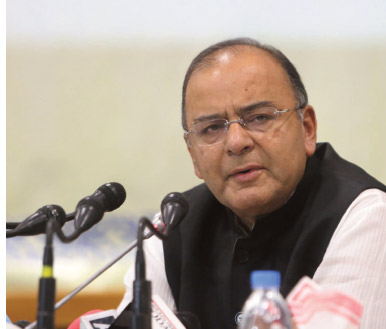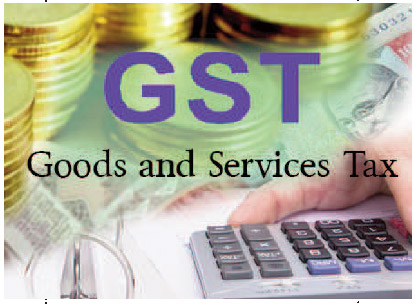An ideal GST yet to come
 Jaya Raj
Jaya Raj
 Arun Jaitley PThe final set of four bills
necessary to roll out the
Goods and Services Tax
(GST) reform in the
country secured
Parliament's approval on
April 6, paving the way for its
introduction on July 1.
Highlighting the uniqueness of
this tax collection reform while
replying to the debate on the last set
of bills in the Lok Sabha, Finance
Minister Arun Jaitley said for the first
time the Centre and the States have come together and pooled their
sovereignty into the GST Council to
make it a reality. The rollout has
become possible after the States and
the Centre agreed to merge their
existing taxation powers given by the
Constitution to evolve a uniform tax
structure.
Arun Jaitley PThe final set of four bills
necessary to roll out the
Goods and Services Tax
(GST) reform in the
country secured
Parliament's approval on
April 6, paving the way for its
introduction on July 1.
Highlighting the uniqueness of
this tax collection reform while
replying to the debate on the last set
of bills in the Lok Sabha, Finance
Minister Arun Jaitley said for the first
time the Centre and the States have come together and pooled their
sovereignty into the GST Council to
make it a reality. The rollout has
become possible after the States and
the Centre agreed to merge their
existing taxation powers given by the
Constitution to evolve a uniform tax
structure.
Parliament had passed the initial
Constitution Amendment bill, the
first step for changing the tax
collection pattern, on August 8, 2016
after years of holding up its passage
in Parliament, by political opposition,
first by BJP and post-2014 by
Congress party which commanded a
majority in the Rajya Sabha despite
BJP handsomely winning the Lok
Sabha elections.
Now, with Parliament finally
clearing all legislative formalities,
India is just a step away from rolling
out an indirect tax reform that will for
the first time economically unify the
country.
The International Monitory Fund
(IMF) summed up that the adoption
of the GST could help raise India's
medium-term gross domestic
product (GDP) growth to over 8 per
cent and create a single national
market for enhancing the efficiency
of the movement of goods and
services.
The IMF said larger than expected
gains from the GST and further
structural reforms could lead to
significantly stronger growth, while a
sustained period of continued low
global energy prices would also be
beneficial to India.
The GST will replace nearly a
dozen central and state levies into a
single national sales tax. It will make
the movement of goods cheaper and
seamless across the country. It is
bound to be far simpler than the
current system, where a good is
taxed multiple times and at different
rates.
With the implementation of GST,
consumers will not be subjected to
double taxation. All taxes that
are levied while purchasing good
will include both the central
government's taxes as well as the
state government's taxes. The move
would deter state governments
from indiscriminately increasing taxes fearing public backlash.
In the final form, it may not be a
single rate of GST for all goods, but
there would be four tax slabs of 5, 12,
18 and 28 per cent. The GST Council
is yet to decide which goods should
fall in which slab. Revenue Secretary
Hasmukh Adhia has stated that the
rates under GST will be broadly in
line with the current existing rates,
ruling out windfall tax slashes the
people were expecting from GST
initially.
Under the GST, there
would be only one tax
from the manufacturer
to the consumer,
leading to transparency
of taxes paid to the final
consumer. Besides,
there will be relief in
overall tax burden. This
is because under the
GST regime, the entire
supply chain will be
efficient leading to gains
and prevention of
leakages. This will result
in the overall tax burden
on most commodities to
come down, which will
benefit consumers.
Finalisation of rate of tax is
another complex area that will take
time. The tax slab may not be
finalised before end-May or even
early June. It would give only one
month or so for companies to decide
the prices of products in a post-GST
regime.
While the GST Act is in place, the
rules covering the Act are yet to be
framed. These include very critical aspects relating to valuation
(including related party transactions
and inter-state stock transfers), input
credits including the credits
pertaining to transition stock, and
manner of inter-office invoices.
It will not be an easy task,
especially for products on which the
rates vary in different states, like
edible items and agricultural
commodities, IT products and
mobile phones, and used cars.
The real issue would be the
applicability of cess on
demerit goods. On four
demerit items — luxury cars,
aerated drinks, pan masala
and tobacco — that are now
taxed at around 40-65 per
cent, there could be an
additional cess. It could be
over and above the highest tax
slab of GST of 28 per cent.
Justification for it is that it was
being done to compensate
states for any revenue losses
in the first five years of GST
implementation. Thereafter it will be
discontinued.
Under the GST, there would be
only one tax from the manufacturer
to the consumer, leading to
transparency of taxes paid to the
final consumer. Besides, there will be
relief in overall tax burden. This is
because under the GST regime, the
entire supply chain will be efficient
leading to gains and prevention of
leakages. This will result in the overall
tax burden on most commodities to
come down, which will benefit
consumers.
To keep inflation under check,
essential items, including food, which
presently constitute roughly half of
the consumer inflation basket, will be
taxed at zero rate. Other GST rates
will remain broadly in line with the
existing rates.
Greater tax compliance has the
potential to boost revenues for the
government, helping narrow the
country's widest budget deficit
among Asian economies and
allowing more funds to be allocated
to schools and highways.
 An ideal GST will transform
the business landscape of India
by bringing about uniformity in
taxation throughout the country,
much to the advantage of investors
and traders who have remained
bogged down by multiple taxes and
ambiguity over tax regulations. In
fact, GST will turn out to be a
game changer for all sectors of the economy in the long run.
Companies will have to overhaul
their accounting systems, which may
involve one-time investment costs.
There may also be chaos in the short
term as the government gets the
computer software up and running.
The government has trained 49,000
officers of the states and the Centre
till last week.
An ideal GST will transform
the business landscape of India
by bringing about uniformity in
taxation throughout the country,
much to the advantage of investors
and traders who have remained
bogged down by multiple taxes and
ambiguity over tax regulations. In
fact, GST will turn out to be a
game changer for all sectors of the economy in the long run.
Companies will have to overhaul
their accounting systems, which may
involve one-time investment costs.
There may also be chaos in the short
term as the government gets the
computer software up and running.
The government has trained 49,000
officers of the states and the Centre
till last week.
The GST Network
(GSTN)—GST's IT infrastructure
arm—and CBEC together will now
Looks like GST would
deliver many of its
originally expected
simplifications. However,
citizens would have to wait
some years for the much
lower tax levels it
promised in the beginning.
This is because the states
that have pledged support
for cooperative federalism
do have competing and
diverse interests and need
more revenue.
conduct trainings so that businesses
know how to file their returns.
Through the GST Network (GSTN),
the Government is working to
provide the technology backbone to
introduce GST and connect the
databases of states and the Centre
which will ease some of the burden
on corporations.
Logistics companies stand to gain
as it becomes easier to ferry
goods across India. Other
sectors largely depend on
the fine print of the GST,
including exemptions.
A complex tax structure in
the old system and poor
infrastructure have
increased the logistics cost to
14 per cent of the value of
the good in India vis-à-vis 7-8
per cent in developed
countries. GST will eliminate
the multiple state taxes and
hence, lower inspection time
at various check posts on
state-borders. This will simplify the
transportation between any two
points in India at a lowest possible
cost.
Looks like GST would deliver many
of its originally expected
simplifications. However, citizens
would have to wait some years for
the much lower tax levels it promised
in the beginning. This is because the
states that have pledged support for
cooperative federalism do have
competing and diverse interests and
need more revenue. Every state will
press for its pound of higher
revenues.
That is why the IMF has cautioned
that the GST should have minimal
exemptions, uniform cross-state
rates, and as few tax rate tiers as
possible. It advises that key
production inputs, such as energy
and real estate, should be kept within
the tax base to enable greater output
gains and reduce the tax burden
across sectors. At the moment,
many petroleum products and
potable alcohol are kept out of the
GST. It needs correction at some
point of time.




 Jaya Raj
Jaya Raj Arun Jaitley
Arun Jaitley